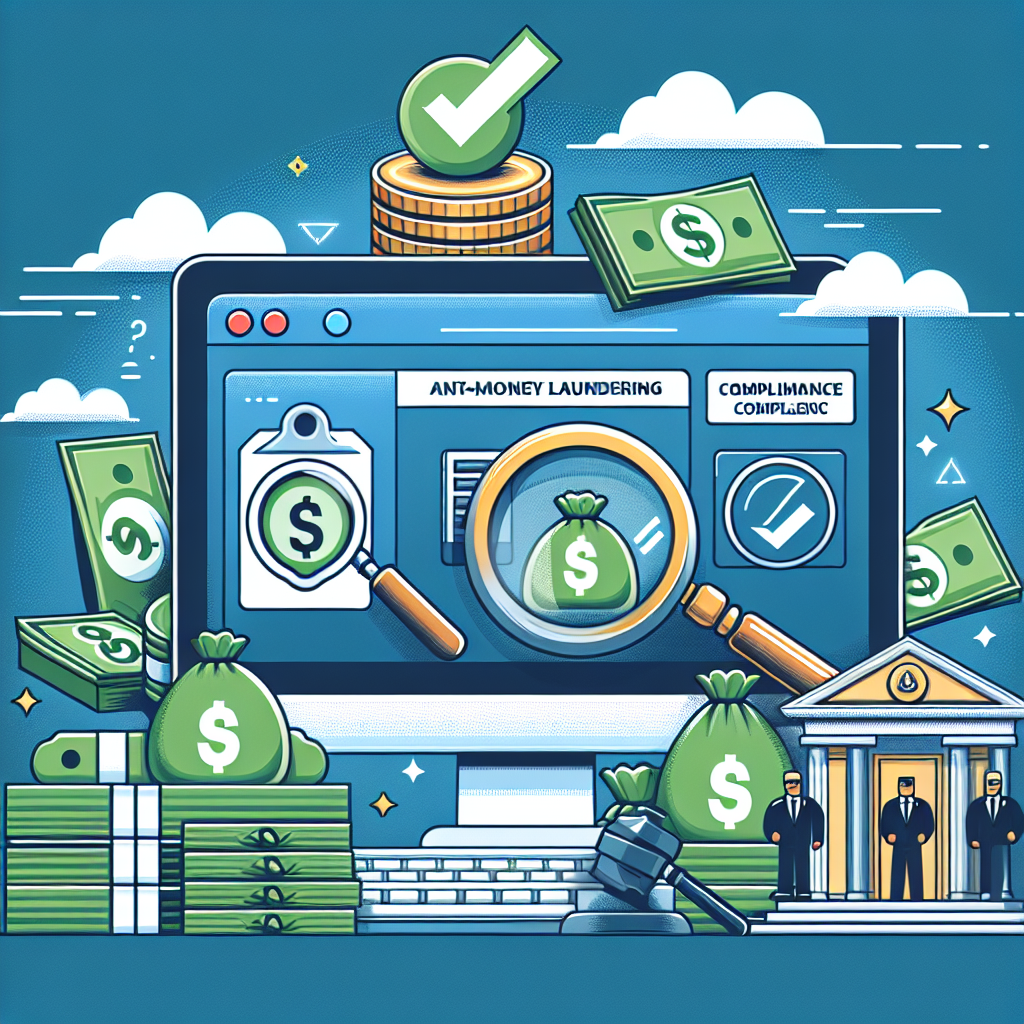In the complex world of financial crime, staying ahead of the curve is crucial. Anti-money laundering (AML) software plays a pivotal role in this endeavor.
These advanced tools help financial institutions detect and prevent illicit activities. They also ensure compliance with ever-evolving regulatory requirements.
But with a plethora of options available, choosing the best AML software can be a daunting task. It requires a deep understanding of your institution's needs and the capabilities of different software solutions.
This guide aims to simplify that process. It will provide insights into the latest trends and technologies in AML software, from AI and machine learning to advanced analytics.
By the end, you'll have a clearer idea of what to look for when selecting the right AML software. You'll also understand how to leverage these tools to enhance your compliance efforts and investigative techniques.
Let's delve into the world of AML software.
Understanding the Importance of AML Software
AML software serves as a vital component in the fight against financial crime. It automates the detection of suspicious activities, increasing efficiency. This is especially crucial given the sheer volume of transactions handled daily by financial institutions.
Without robust AML software solutions, compliance teams would face overwhelming challenges. Manual checks are not only time-consuming but also prone to human error. With technology, the likelihood of overlooking illicit activity drops significantly.
These tools are designed to adapt to new forms of financial crime. As criminals develop new techniques, AML tools evolve to combat these threats. This adaptability ensures continuous protection against emerging risks.
Furthermore, integrating AML software with existing systems enhances overall efficiency. Seamless integration allows for data consolidation, providing a unified view of potential threats. This comprehensive approach strengthens risk management strategies.
Overall, AML software doesn't just facilitate compliance; it empowers institutions to proactively manage risk. By providing comprehensive monitoring and intelligence, these tools fortify an institution's defenses against financial crime.
The Role of AML Software in Regulatory Compliance
Regulatory compliance is a cornerstone of financial operations. AML software supports this by ensuring adherence to legal frameworks. These tools provide automatic updates aligned with changing regulations.
They ensure institutions remain compliant without needing extensive manual intervention. This proactive adaptation reduces the risk of penalties and legal issues.
By utilizing AML software, financial institutions build trust with regulators. This trust is pivotal for maintaining a good reputation and operational integrity.
Advanced Analytics and AI in AML Detection
Advanced analytics play a critical role in modern AML software. They help identify patterns indicative of money laundering activities. By analyzing vast amounts of data, these tools spot anomalies quickly and accurately.
AI and machine learning further enhance detection capabilities. They learn from historical data to predict new trends and threats. This predictive power is essential in staying ahead of sophisticated financial crimes.
One significant advantage is reducing false positives. Excessive false alerts can overwhelm compliance teams. Advanced technology improves accuracy, allowing teams to focus on genuine threats.
Ultimately, incorporating AI and advanced analytics transforms AML efforts. It allows institutions to move beyond reactive measures, providing a proactive strategy against financial crimes. This advancement not only improves efficiency but also strengthens the institution's overall security posture.
Key Features of Top AML Software Solutions
Choosing the best AML software requires understanding its key features. These characteristics enhance its effectiveness and align it with your institutional needs.
Firstly, the software must offer robust AML transaction monitoring capabilities. This includes real-time analysis of transactions to detect suspicious activity. It's crucial for identifying risks before they escalate.
Secondly, advanced analytics and AI are integral. They provide deeper insights and automate routine tasks. By leveraging AI, institutions can stay ahead of ever-evolving threats.
Key Features Checklist
- Transaction Monitoring: Real-time surveillance to identify suspicious activities.
- Advanced Analytics: Deep insights and pattern recognition for enhanced analysis.
- Customizability: Ability to adapt to specific institutional requirements.
- Scalability: Capability to grow with the institution's needs.
- User Interface: Intuitive and user-friendly for efficient operation.
These features ensure the software remains future-proof. They allow it to adapt to regulatory changes and emerging financial crimes.
AI and Machine Learning Capabilities
AI and machine learning capabilities are game-changers in AML software. They optimize data processing, making it faster and more precise. This automation allows compliance teams to concentrate on complex cases.
Machine learning models adapt and learn from new data. This adaptability helps in predicting and preventing unknown threats. Over time, models improve, providing more value to the institution.
By leveraging AI, AML software becomes a proactive defender. It continuously evolves, offering robust protection against sophisticated laundering schemes.
Reducing False Positives with Advanced Technology
False positives can burden compliance teams significantly. However, advanced technologies effectively mitigate this issue. They employ precise algorithms to distinguish benign transactions from suspicious ones.
Fewer false alerts enhance operational efficiency. Teams can then focus their efforts on authentic cases, improving overall security.
Thus, reducing false positives is not just about efficiency. It's about enhancing the strategic focus of compliance efforts.
Integration with Existing Systems and Data Sources
Seamless integration is vital for AML software effectiveness. The ability to connect with existing systems reduces implementation hurdles. It ensures that all data sources are unified for comprehensive analysis.
This compatibility facilitates streamlined processes across departments. As a result, institutions gain a holistic view of risks.
A software solution that integrates well with your existing infrastructure maximizes its utility. It supports better decision-making without disrupting current operations.
Customer Due Diligence and Risk Management
Customer due diligence is a cornerstone of AML compliance. Effective software aids in thoroughly vetting customer backgrounds. This preemptive action helps in identifying potential risks early.
Risk management modules within AML software are crucial. They provide tools to assess and categorize risks efficiently. Such assessment guides strategic planning in safeguarding assets.
Ultimately, these features empower institutions to build a robust AML strategy. They allow for proactive threat identification and mitigation, reinforcing overall security.
Selecting the Right AML Software for Your Institution
Selecting the right AML software begins with understanding your specific needs. Each institution has unique requirements based on its size, clientele, and risk profile. A tailored approach ensures that the software aligns perfectly with these specifics.
Engage your compliance and risk team in the decision-making process. Their insights will be invaluable in evaluating software capabilities. They will help determine the critical features that support compliance and risk management.
Scalability and flexibility are essential for your institution. The software should grow with your needs and adapt to regulatory changes seamlessly. This capacity for growth ensures long-term efficiency and cost-effectiveness.
Additionally, prioritize vendor reputation and market standing. A reliable vendor provides not only robust software but also a partnership for compliance success. Their track record can be a compelling indicator of future performance.
Finally, consider the total cost of ownership, including licensing, training, and ongoing support. A comprehensive analysis prevents unforeseen costs and ensures you get the most value from your investment.
Assessing Your Institution's Specific Needs
Understanding your institution's unique needs is the foundation of selecting effective AML software. Start by assessing your current AML processes and identifying any gaps.
Consider the complexity of your operations and the volume of transactions handled. These factors will influence the software's required features and capabilities.
Engage with stakeholders across departments to gain diverse perspectives. Their input will provide a holistic view of institutional needs, aiding in accurate software selection.
Evaluating AML Software: A Checklist
A structured evaluation process ensures you choose the right AML software. Use the following checklist to guide your assessment:
- Customization Options: Is the software adaptable to your specific requirements?
- User Experience: Is the interface intuitive for easy use by all team members?
- Data Security: Does it offer strong encryption and data protection measures?
- Compliance Reporting: Are the reporting tools efficient and comprehensive?
- Vendor Support: Is there access to reliable technical and customer support?
Each aspect plays a pivotal role in determining software suitability. Prioritize according to your institution's focus and regulatory landscape.
This checklist offers a basis for thorough evaluation, leading to a well-informed decision. Adjust it based on your specific objectives to maximize relevance and impact.
The Importance of Customer Support and Training
Customer support is a cornerstone of successful AML software implementation. It ensures any challenges encountered are swiftly addressed, minimizing disruption.
Training programs provided by vendors enhance software usability. They equip your team with the knowledge to maximize software functionality effectively.
Moreover, a well-supported and trained compliance team operates more confidently. This empowerment leads to improved compliance performance and risk management efforts.
Leveraging AML Software for Enhanced Compliance Efforts
AML software significantly bolsters compliance efforts by streamlining complex processes. It automates routine monitoring tasks, allowing compliance teams to focus on analysis. This automation leads to better resource allocation and increased efficiency.
Advanced analytics embedded in AML solutions enhance transaction monitoring capabilities. These tools detect intricate patterns and anomalies that manual efforts might miss. As a result, institutions experience improved accuracy in spotting potential risks.
Furthermore, leveraging AI in AML software minimizes false positives. A reduction in false alerts means investigators can concentrate on genuine threats. This focus supports more effective investigations and regulatory adherence.
AML software also ensures compliance with evolving global regulations. Continuous updates from vendors keep systems aligned with new laws. This agility is crucial in maintaining up-to-date compliance across international operations.
Real-World Success Stories and Case Studies
Several financial institutions have revolutionized their compliance strategies with AML software. One bank reported a 40% drop in false positives post-implementation. This reduction significantly improved operational efficiency.
Another institution, adopting advanced analytics in AML tools, saw enhanced risk profiling. Their compliance team could swiftly identify suspicious activities, garnering regulatory accolades.
These success stories illustrate the tangible benefits of incorporating robust AML solutions. They underscore the importance of selecting software that aligns with an institution's distinct needs.
Future Trends in AML Software Development
AML software continues to evolve, with AI and machine learning leading advancements. Future solutions will likely feature predictive analytics to anticipate emerging threats. This capability will further refine the accuracy of risk assessments.
Moreover, cross-border collaboration efforts will shape software development. Unified frameworks aim to address international regulatory variances, enhancing global compliance.
Lastly, cloud-based solutions promise enhanced scalability and accessibility. Institutions can deploy these flexible systems to stay agile in a rapidly changing regulatory environment. This trend ensures AML software remains at the forefront of financial crime prevention.
Conclusion: Revolutionize Your AML Compliance with Tookitaki's FinCense
In today's complex financial landscape, ensuring effective anti-money laundering (AML) compliance is paramount. Tookitaki's FinCense stands out as the best AML software, offering banks and fintechs efficient, accurate, and scalable tools designed to meet all your compliance needs. By leveraging Tookitaki's advanced AFC Ecosystem, you can achieve 100% risk coverage for all AML compliance scenarios, providing comprehensive and up-to-date protection against financial crimes.
FinCense significantly reduces compliance operations costs by an impressive 50%. By harnessing its machine-learning capabilities, compliance teams can reduce false positives and concentrate on material risks, drastically improving service-level agreements (SLAs) for compliance reporting such as suspicious transaction reports (STRs). With an unmatched 90% accuracy in AML compliance, FinCense ensures real-time detection of suspicious activities, allowing institutions to act decisively and effectively.
The solution excels in transaction monitoring, utilizing the AFC Ecosystem to provide 100% coverage against the latest typologies identified by global experts. With the ability to monitor billions of transactions in real-time, fraud and money laundering risks are effectively mitigated. The automated sandbox feature reduces deployment efforts by 70% while cutting false positives by 90%.
FinCense's onboarding suite enhances customer due diligence by screening multiple attributes in real-time, ensuring accurate risk profiles for millions of customers. Its seamless integration with KYC/onboarding systems via real-time APIs enhances overall efficiency.
Smart screening capabilities allow institutions to ensure regulatory compliance by accurately matching customers against sanctions, PEP, and adverse media lists in 25+ languages. The built-in sandbox for testing new configurations reduces effort by 70%, ensuring adaptability in compliance processes.
Customer risk scoring is enhanced through a dynamic risk engine that provides a 360-degree risk profile using a combination of supervised and unsupervised models. This capability visualizes hidden risks and complex relationships, ensuring informed decision-making.
FinCense's smart alert management system employs powerful AI to reduce false positives by up to 70%. Its explainable AI framework promotes transparency in alert analysis, allowing institutions to maintain high accuracy over time. Integration with existing systems is seamless, facilitating a faster go-live process.
Lastly, the case manager feature provides an all-encompassing view of relevant case information. Alerts are aggregated at a customer level, enabling more efficient investigations and automation of STR report generation, ultimately reducing investigation handling time by 40%.
With Tookitaki's FinCense, you can transform your AML compliance efforts into a robust, efficient, and future-ready framework that not only meets regulatory demands but also adapts to the evolving landscape of financial crime. Embrace the power of FinCense to revolutionize your AML strategy today!
Anti-Financial Crime Compliance with Tookitaki?






